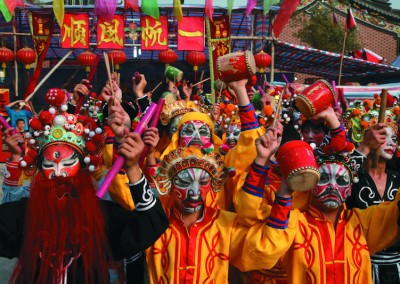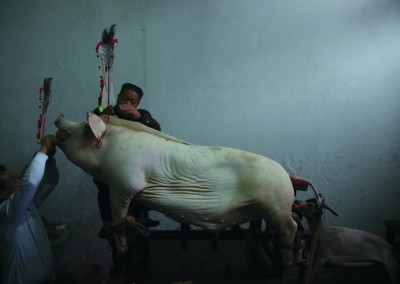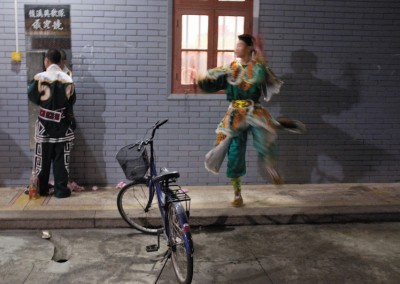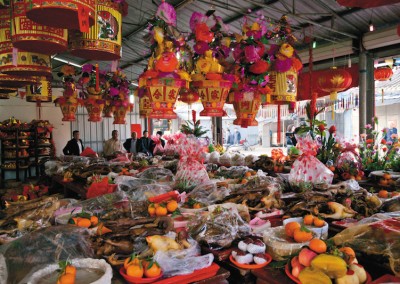Visiting and Returning 到访与还乡
Visiting and Returning
Cuator : John Chang
Different cultural contexts about the same Subject Of the Photography
All photos exhibited here are the works containing the thick local custom of Chaozhou, a city in the east of Guangdong province. When you come to the front counter, you will find that all the 80 pieces are just like the wonderful flowers, fresh and vivid, which you will feel to find them suddenly when you wake up. Behind the screen, you will see a spectacular cooperation between the two famous photographers. They took the photos at the same time ( during the Chinese Spring Festival), in the same area (the Chaoshan district in Guangdong province), and for the same theme(the rich local folk-custom activity in Chaoyang district during the Chinese Spring Festival).
However, the presentations are quite different.
Hiroji Kubota, the famous photographer working with the Magnum photos, made up his mind to be a photographer after his graduation from the political dept. in Tokyo University, and went to America for 6 years in learning photography. He had studied in New York and Chicago. His dream came true after he completed all his study. In year after becoming a photographer, Hiroji Kubota joined the Magnum photos the 3rd and are honored to be it’s official employee. He started his career as a freelance in photography and began to provide special coverage to the western media. Obviously, Hiroji Kubota had completed his photography training under the western thinking context, though he received his early education in Japan. Besides, after nearly 40 years working in the western photography organization, his images of humanity for people from every parts of the world with different nationalities have been recognized by global main media. And by this he has built up his international view. His colleagues include the world renowned talented persons such as Henri Cartier- Bresson, Robert Capa, David Seymour, Marc Riboud etc.
Cai Huansong, the art supervisor for the , is a famous photographer from the Chaoshan area. In the very beginning of his photographic career, like most photographers in that horizon hazy age, he had also experienced a long time Sharon enlightenment. Fortunately, he was special with an aggressive heart and the ability of self examination. He was never satisfied with imitation and the inflexible management on his skillful ideas. Then he was inspired to think deeply on the photography ontological return., and finally he has got full confidence at the age of forty. For a man working years for Sharon photography and with full knowledge on theory of photographic history , he was no longer satisfied with the sweat flavor. Inevitably, he would go out and began to work on the research and record of the photography history, as well as on the practice of conceptual photography. This has symbolized that Cai huansong has built up his own photography frame. In the area of photography theory, he got his first research thesis published in 1985 named on the Chinese photography theory collection. Starting from then, many books on the photography edited under his leadership had been highly praised by people in this field. Therefore in the year of 2009, he got the Chinese Photography Awards. On the photographic practice, he has been paying th 8 attention to the traditional culture in his homeland. During a talk with Hiroji Kubota, Cai huansong’s photo named caught the latter’s eyes. In this way, these two photographers with quite different culture backgrounds got their first culture intersection and agreed to go to Chaoshan for taking photos during the Chinese Spring Festival in 2012. Therefore, we are able to see this exhibition today. If we put those photos on the Chaoshan folk-custom by Hiroji Kubota as his visiting to this area, those by Cai huansong mean without any doubt his homecoming. This tour going hand in hand was really a behavior of charm.
Based on their different culture backgrounds , different professional careers and different outlook of value, these two photographers will surely use different ways in the presentation of the same scene for the same theme psychologically and consciously., i.e. the different culture context. When we review their photos from the humanistic direction, we will find that they have combined their own culture immersion into the same theme on the Chaozhou traditional culture. However, it doesn’t mean convergence. Hiroji Kubota, who represents the western context, posses deep western humanistic quality. He was subtle, integrated with macro and micro, thanks to his study on western documentary photography system and aesthetic system. Our first impression on his photos would be about his attention paid to humans driven by the western concept of human respect. Therefore, his focus is always on humans. By revealing stories through people’s expressions, their manners, the moment of their actions , reviewers will be soon taken into the special scene. Another point is strange vision from the visitor (for example, the young girl in ancient custom wearing a pair of sunglasses). Being a visitor, Hiroji Kubota may be anxious of missing any scene about the local custom. Due to his being unfamiliar with the local custom, or because of his professional attitude, or because of the both, he has tried his best to record all aspects of the event. Therefore, in all of his photos, every scene is an all-direction vision made up by a set of complete images. There are also astonishing surprises about some details which would be often overlooked( the words on the incense sticks and the curling up smoke in the temple are seen but there is no prayer shown up. The prayers are ignored on purpose). In the same time, although he was far away from the objects that he was taking photos on, this is mainly for the respect to the subjects and non interfering principal, he was still able to use the zoom lens to cover the shortage and to make the vision enter directly into the scene, thus to build up a live feeling and show more clearly the details ( for example, on the puppet opera, his photos show not only the action scene but also the people who control the threads, signing and speaking). His fields of image are always go along with people’s fields of vision. It is this typical kind of affinity from the Magnum field of view that present a kind of reality to readers who have never been personally in the image fields.
Being the newly rouse Chinese generation as a photographer, Cai huansong has fixed love to the local custom of his homeland. His thinking was nourished by the mother culture. Here we can simply definite his image statement as Chaoshan local context according to his personal identity. Although he has been working and living in provincial capitals and also in Beijing , the Chinese political and economic center, he has been paying high attention to the local culture of his homeland by documentary photography. This is because that he has a pure heart and his love to the homeland. In his home field, he knew very well the local culture, it’s ceremony, it’s spectacle and his fellow villagers. This is his advantage, yet also his disadvantage, because on one hand, he can control easily the photo taking since he is very familiar with the subjects under shot, but on the other hand, he may have visual blind spot also due to the above reason. About this issue, unlike Hiroji Kubota who had to push himself to be familiar with the subject from a stranger, Cai huansong tried his best to get out of what he had been familiar with and made an acute activation to his vision and tactile sense. From the point of mental emotion, Cai huansong made his tour as a feeding to his homeland where he was brought up. Therefore, in the whole shooting process, he was able to control accurately every ritual shooting points. To a large extent, his watching vision is the same as that of his fellow villagers. He was able to join the performance made by the villagers thanks to his regional identity, his fluent local dialect. This is also proved by the shooting positions in many of his photos. Through the visual spatial scheduling such as by using the wide angle lens, low angle shooting, approach shooting etc., he showed his respect to the local traditional culture, and also endowed his all works with strong visual tension and emotional appeal.
In the whole procedure of this exhibition planning, we have tried to start from the individual analysis to the photographers and to have an academic study on all of their works. We have concluded that we can still find the different statements under the different culture context though we are facing the globalization. This will help us to explore the different results of image representation under the content of intercultural communication. Visitors may also take an active part in reviewing the photos through the bridge of image statement built up between the different contexts by the two photographers.
到访与还乡——同一摄影主题下的不同文化语境陈述
文:张 展
这里展出的,是洋溢着浓郁乡土气息的潮州民俗摄影作品。台前,整个展览的80幅作品如一觉醒来一眼看见窗前有奇葩,鲜活,意趣盎然令人雀跃;幕后,联袂的两位摄影师其合作的形式更是别开生面:同一拍摄时间(中国春节),同一拍摄地点(中国广东省潮汕地区),同一的拍摄题材(潮汕地区春节期间丰富多彩的民俗活动),却有着完全不同的呈现。
久保田博二,全球著名摄影机构玛格南摄影通讯社(Magnum Photos)著名摄影师。东京大学政治系毕业后立志要成为一名摄影师,遂远赴美国,用了六年时间先后辗转于纽约和芝加哥学习摄影。学成,愿望也随之达成,以自由摄影师的身份开展自己的职业生涯并开始为西方媒体拍摄专题报道。在当上摄影师的第三年久保田博二加入了玛格南,并在几近严苛的优胜劣汰机制中赢得了被接纳为玛格南正式成员的荣耀。显而易见,久保田博二虽然早期接受的教育在其本土,但他所接受的摄影专业训练则完全是在西方的思维语境下完成的,加之在他日后为玛格南图片社这一代表着西方主流摄影机构服务的四十多年的岁月里,面对世界各地区各民族的人文影像的陈述已然形成了一种得到全球主流媒体认可的国际视野。他的同僚有大家熟知的亨利·卡蒂埃·布列松(Henri Cartier-Bresson)、罗伯特·卡帕(Robert Capa)、大卫·西蒙(David Seymour)、马克·吕布(Marc Riboud )等世界翘楚。
蔡焕松,《中国摄影家》杂志艺术总监,从潮汕本土走出的摄影家。在踏上摄影道路之初,他与所处的那个视野雾霾年代的大多数摄影人一样,在成长的经历里都有过一段漫长的沙龙启蒙期。所幸的是他拥有别于常人的进取之心以及自我审视的自觉与自省能力,从一开始不满足于画意的刻意模仿与匠意的僵硬经营继而激发了他对摄影本体回归的思考,进而成就了其不惑之年的不惑。对于一个在沙龙摄影浸淫多年而又广猎摄影史论的人来说,甜美的画意早已不是他盘中的菜,其出走似乎势成必然。接下来,在摄影领域的两个发展方向——史论的研究和纪实、观念摄影的践行,标志着蔡焕松已完成了自己的摄影构架。摄影理论方面,自1985年在中国摄影理论丛书《当代中国的摄影思潮》发表的摄影家个案研究论文《礼赞自然·人化自然——论陈复礼与亚当斯摄影风格的异同》作为标志性起点,他主持编撰的众多摄影史论书藉均获得业界的极高赞誉,因而2009年获得第八届中国摄影金像奖。在摄影实践方面,他以纪实摄影的手法关注着中国尤其是自己家乡潮汕的传统文化。
在一次两人的交谈中,蔡焕松的一组反映潮汕地区传统民间风俗“成人礼”的摄影作品牢牢地抓住了久保田博二的眼球。就这样,两位有着不同文化背景的摄影师就有了这样一次人文背景下的交集,相约2012年春节到蔡焕松的家乡潮汕地区拍摄。于是,也就有了今天呈现在观众面前的摄影展。如果说,作为玛格南摄影通讯社摄影师的久保田博二的此番拍摄是一次对潮州民俗的到访,那么对于蔡焕松来说无疑就是一次还乡的旅程。
这样的联袂本身就极具行为魅力。两位摄影师基于各自不同的文化背景,不同的职业养成乃至不同的价值观去同时面对同一摄影题材的同一场景的时候,必然会由于内在心理、意识等思维活动的差异在观看的角度和表现的方式上产生明显的差异性,亦即文化语境的差异性。当我们从人文观看的维度去审视这两位摄影师的影像时会发现:两位摄影师都将各自的文化濡染融入到潮州传统文化这一共同的观看主体中来,但这本身并不意味着趋同。代表着西方语境的久保田博二,有着深厚的西方人文素养。西方的纪实摄影体系、美学体系培养了他洞幽烛微的敏锐观察力,宏微俱翔的表现能力,同时兼具视觉美感等专业品格。其作品给人的第一感觉是在西方人文尊重理念驱动下对人的关注。因此,他的视线切入点始终是人,透过人物的表情、神态、动作瞬间作为故事展开的提挈,令读者的情绪很快便进入每一个特定的场景中。其次就是作为访者的陌生视角令他触及到了诸多的文化症候(如身穿古装的少女带上时髦墨镜以及头戴斗笠的骑摩托车者)。可能是作为访者的他,担心自己因对当地传统习俗的不熟悉而挂一漏万,或是职业素养的使然,或者两者皆然,使得他力图全面地记录下整个事件。故在他的作品里,每一个场景都是由一组完整影像构成的全方位视角。而且对一些极可能被忽略的细节往往都有令人拍案的惊喜(庙堂上香故意忽略信众,转而突出印在香上的祈福语句及袅袅升烟)。同时,他的观看距离虽然是出于对拍摄对象的尊重和不干预的法则,但变焦镜头的灵活运用弥补了这一不足,使视觉尽可能直接进入画面主体,在画面上既可以营造一种现场感,也可以更利于情节上的清晰交代(如傀儡戏,不光有木偶的形体做打还要在画面上同时拍到提线操纵念唱的艺人)。他的视觉像场常常与人的肉眼视场保持一致,也就是这种玛格南典型视场所营造的亲和力,毫不夸张地向没有亲临现场的读者呈现一种现场的真实。
作为中国新觉醒一代摄影人的蔡焕松,对故土的深厚情感令他对家乡风俗总怀有一份难舍的炽爱。他的思维是受到母文化滋养的,在这里或许我们可以索性将他的影像陈述语境按照他的身份定位为潮汕本土语境。虽长期工作生活在省会都市及中国政治、文化中心北京,但赤子之心所系,故土之情难离,对故乡传统风俗的文化担当促使他倾注心力地关注潮州民俗并将这种关注落到用纪实摄影对乡土文化进行梳理。出于对家乡文化日渐畸变消蚀的焦虑,当我们纵观他的作品时能感受到他的迫切感在镜头前的流露,一种近乎抢救式的拍摄心态昭然。在自己的主场,凭借的是对本土文化的了然,熟知的仪式,熟知的场景,熟知的乡党。这是他的一利,同时也是他的一弊。对拍摄主题的谙熟就意味着可以轻松驾驭,但另一方面也很有可能因为熟悉而产生视觉盲点。关于这一点,蔡焕松并不像久保田博二那样使自己尽快地从陌生转入熟知的迫切,而是反其道而行之,努力使自己从熟视的无视中跳转,从司空见惯的场景中作一次视觉触角的敏锐激活,这就需要从熟知转向陌生。从情感心理角度而言,蔡焕松此次的还乡之行更像是对养育了自己的潮汕大地的一种反哺。因此,他在整个拍摄的过程中总能从容应对,对各种仪轨拍摄节点的把控精准。蔡焕松的观看视角在很大程度上就是乡党的视角,地缘身份的认同,语言的无障碍交流使他得以“混迹”于群众甚至巡游、演出队伍当中,从他许多作品的拍摄机位便可证实这一点。而广角、低角度、逼近仰拍等视觉空间调度则体现了他对本土传统文化的崇敬态度,同时也赋予了作品极强的视觉张力及情感的感召力。
本次展览的策展思考过程中,我试图从摄影师个案分析的角度切入,在学术的框架内加以研究。通过对跨语境下影像表述的差异性探究,将有助于我们去解决一些法则上的存疑问题。首先,我们应当承认,即便在当今全球化趋势日益明显的大背景下,我们仍然看到在不同文化语境下潜含的不同观看。但是,只要本着职业良知和文化传播者与历史见证者的责任感,摄影师的不同文化语境并没有使纪实摄影的真实性产生改变。任何关于纪实摄影的差异性表述会否影响其社会文本真实价值以及纪实摄影能否拥有属于自己个性语言等严肃问题的争论,透过这样一次别开生面的玛格南西方语境和中国本土语境在同一主题下的影像对话,使题面更清晰明了,其结论不言自明。透过这样一个展览,我们可以漫步在久保田博二和蔡焕松这两位摄影师在不同文化语境之间架设的这座影像陈述的桥梁上,一边细赏丰富多彩的潮州传统文化一边踱步思考,来完成自己参与其中的共同观看。
























